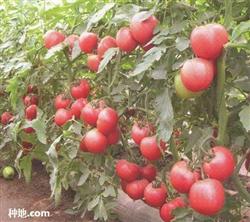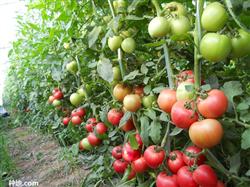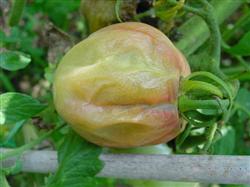How to grow tomatoes in open field

How to grow tomatoes in open field? Please introduce the instructions for planting tomatoes in the open field. Please refer to the following methods: 1. The environment of the producing area should choose the loam land with high dry terrain, convenient drainage and irrigation, low groundwater level, deep and loose soil layer, and meet the environmental requirements for the safety and quality of agricultural products and pollution-free vegetable producing areas issued by GB/T 18407.1. two。 Seeds: the quality of seeds accords with DB 3703003mur2002 "guidelines for the use of inputs for pollution-free vegetable production". Select varieties with disease resistance, high quality, high yield, good merchandise, resistance to storage and transportation, and suitable for market demand. Refuse to use genetically modified tomato varieties. 2.1 seed treatment 2.1.1 soaking seeds in warm soup: put the seeds in 55 ℃ hot water, stir to 30 ℃ and soak for 4 hours. Mainly control leaf mildew, canker, early blight and late blight. 2.1.2 soaking seeds with trisodium phosphate: first soak the seeds in clear water for 4 hours, then soak them in 10% trisodium phosphate solution for 20 minutes, remove and wash them, mainly to prevent and cure virus. 2.1.3 dry heat treatment: the dried seeds were treated in an 80 ℃ incubator for 48 hours, which could effectively prevent and cure the virus. 2.2 after seed soaking and seed soaking, the seeds were placed under the condition of 25mur28 ℃ to accelerate germination, and the seeds could be sown after 60% of the seeds were germinated. 3. Cultivate strong seedlings without disease and insect pests 3.1 prepare 3.1.1 before sowing, select greenhouse, greenhouse, sunny beds and other seedling facilities, in order to effectively control diseases and insect pests, seedlings should be equipped with anti-pest sunshade facilities. 3.1.2 to prepare nutritious soil: use 1Compact 3 fully mature ring fertilizer, 2Compact 3 pathogen-free mature soil, pat and sift; add calcium superphosphate 1kg, plant ash 5kg or nitrogen, phosphorus and potassium compound fertilizer 2kg per m3 of nutritious soil. 3.1.3 Seedling bed disinfection: one of the following two methods can be used: one is to use formalin 30-50ml per m2 of seeding bed, add 3L of water, spray bed soil, cover the film with plastic film for 3 days, and sow after the smell has dissipated; second, 50% carbendazim per m3 of nutrient soil is mixed with 80g. 3.2 sowing and raising seedlings 3.2.1 sowing time: the suitable sowing time is from early February to late April. It can be planted or directly seeded. 3.2.2 sowing amount: according to seed size and planting density, per 667m2 cultivation area, the amount of seed used for seedling planting is 20ml / 30g, and the amount of seed used for direct seeding is about 100g. 3.2.3 sowing method: the seeds can be sown when more than 70% of the seeds are exposed to white. Before sowing, the seedling bed was watered with sufficient bottom water and moistened to the depth of the bed soil 10cm. After the water seeped, sprinkle a thin layer of nutritious soil, level the bed surface, then spread evenly, and cover nutritious soil with 0.8-1.0cm after sowing. Each 667m2 nursery bed with 50% carbendazim wettable powder 8 g or 50% seed double powder 7 g, mixed with fine soil evenly sprinkled on the bed surface, to prevent and cure the disease. Actively advocate the use of nutrition bowls, seedling trays, paper bags and other methods of sowing and raising seedlings. 3.3.1 Management before seedling emergence: shade should be carried out in high temperature weather during the day, bed temperature should not exceed 30 ℃, and rainproof film should be covered on rainy days. Don't make the night temperature too high during seedling breeding. After sowing, the soil of the seedling bed should be kept moist and not dry before emergence, and the border can be covered with grass for moisturizing. 3.3.2 Seedling: the seedling was divided at 2 Mel and 3 true leaves. The seedlings were divided into seedling beds prepared with nutritious soil in advance, row spacing 12-13cm, plant spacing 12ml 13cm, or into nutrition bowls with diameter 10-12cm. 3.3.3 Management after seedling division: during the period of seedling retardation after seedling separation, the temperature of the bed should be 25 ℃ 30 ℃ in the daytime and 18 ℃ 20 ℃ at night, and about 25 ℃ in the daytime and 15 ℃ at night. A few days before planting, properly reduce the bed temperature to exercise seedlings. 3.3.4 Disease prevention at seedling stage: disease and insect seedlings and weak seedlings found at seedling stage should be pulled out in time. Fungicides can be sprayed twice at the seedling stage (200mur250-fold Bordeaux liquid is a suitable protective agent, I. e. 1pur200Mel 250) to prevent diseases. 3.3.5 strong seedling standard: 4 leaves and 1 heart, plant height about 15cm, stem diameter about 0.4cm. 4Plantation 4.1 preparation before colonization: soil preparation and fertilization: fertilization should be based on organic fertilizer and combined application of nitrogen, phosphorus, potassium and micro-fertilizer. During soil preparation, 5-7m3 of high quality organic fertilizer, 50-60kg of nitrogen, phosphorus and potassium compound fertilizer, and 100kg of superphosphate were applied per 667m2. After fertilization, the soil was ploughed deeply and the land was leveled. 4.2 colonization 4.2.1 colonization time: generally from early May to late June. 4.2.2 planting method: if those who use nutrition bowls are planted in the soil together, those who do not use nutrition bowls should be watered 4-5 hours before planting, bring more soil and reduce root damage. When planting, the planting density varies according to the characteristics of varieties, the way of pruning, climate and soil conditions, and the purpose of cultivation. Generally, 2500 trees are planted per 667m2. (5) Field management 5.1 Irrigation and drainage: at the initial stage of growth, less water is needed, but in the peak fruiting period, it is the summer high temperature season, with greater evaporation and more water demand. Often every 3-5 days irrigation, to achieve regular quantitative irrigation, combined with fertilization (manure), furrow irrigation should not be higher than the border surface. Alpine summer tomatoes should be fertilized in combination with rainfall. Topdressing: the fertilizer input should conform to DB 3703 / 003mur2002 "guidelines for the use of inputs in the production of pollution-free vegetables". In addition to base fertilizer, there should be sufficient topdressing. Within a week after planting, the "promoting seedling" fertilizer was applied once to promote the vegetative growth of the seedling stage; after the first ear fruit began to expand, the second topdressing should be applied; when the first ear fruit was about to mature, and when the second ear fruit was quite large, the stems and leaves grew again and needed a lot of fertilizer, and the quick fertilizer should be applied for the third time; by the first to second ear fruit harvest, the third to fourth ear fruit was growing rapidly, and the fourth and fifth times of fertilizer should be applied. Topdressing is the same as base fertilizer, it is not suitable to apply nitrogen fertilizer, but to cooperate with phosphorus and potash fertilizer. When using human feces and urine as topdressing, it should be thinner at the initial stage and thicker at the later stage. In the first and second topdressing, 10-15kg superphosphate should be added per 667m2. If yellowish leaves are found in the early stage of growth, ammonium sulfate can be applied once, per 667m215-20kg, the effect is very good. 5.3 Intermediate ploughing, weeding and ground mulching are often combined with weeding and soil cultivation. Generally, the first intermediate ploughing is carried out after planting slow seedlings, and the second is about a month after planting. This time, the middle ploughing is combined with soil cultivation, and the border ditch hoe is cultivated on the border surface and around the plant to raise the border surface. Since then, because the plant has been tall, it is no longer ploughing and cultivating soil. The use of plastic film ground mulching can promote the growth of roots and stems and leaves, blossom and bear fruit earlier and increase yield. 5.4 there are two main ways for plants to adjust pruning: (1) single stem-this method leaves only the trunk and removes all the lateral branches. (2) double trunk type-except for the main branch, leave one side branch from the axil of the first inflorescence straight down the leaf axil, and remove all the other side branches. Pruning and sprouting should not be done too early or too late, because the growth of all parts of the plant interact with each other. The growth of leaf axil can stimulate the growth of root group, and the removal of axillary bud prematurely will affect the growth of root system and cause incomplete development of transport system in root group. Therefore, when the lateral bud grows to 4.7cm, it should be removed at noon on a sunny day to facilitate wound healing. In addition, in the plant adjustment of tomato, it should be combined with flower picking, leaf picking and heart picking and so on. 5.5 Flower and fruit drop and its prevention and control are mainly due to the poor development of floral organ caused by unsuitable external environmental conditions, slow elongation of pollen tube, lack of water and malnutrition caused by the formation of flower stalk detachment. If the reason for falling flowers is due to lack of nutrition and water, too weak sunshine or too much rain, it should be solved from the cultivation techniques. If the temperature is too low or too high, the growth regulator 2.4-D10-20 ppm,PCPA25-50ppm can be used. 5.6 Fruit protection and fruit thinning 5.6.1 Fruit protection: in the season when tomato fruit setting is not suitable, plant growth regulators such as anti-falling hormone and tomato spirit are used to treat flower ears. 5.6.2 fruit thinning: in addition to cherry tomatoes, fruit thinning should be appropriate in order to ensure product quality, including 4 fruits per panicle for large ear varieties and 4 fruit per panicle for medium fruit type varieties. 5.7 the tools used for harvesting should be kept clean, hygienic and pollution-free. It is necessary to harvest in batches in time, reduce the plant burden, ensure the quality of commercial fruit, and promote fruit expansion in the later stage. (6) the principle of pest control 6.1 in accordance with the plant protection policy of "prevention first, comprehensive control", adheres to the harmless control principle of "agricultural control, physical control and biological control, supplemented by chemical control". 6.2 Agricultural control creates suitable conditions to improve plant resistance and reduce the occurrence of diseases and insect pests. Timely removal of diseased leaves, diseased fruit, pull out diseased plants, take out the ground deeply buried or destroyed. 6.3 physical control: using yellow board to trap aphids and whitefly. The method is to hang yellow armyworm board or yellow lath in the shed and coat it with a layer of oil per 667m230-40. 6.4 Biological control of 6.4.1 natural enemies: actively protect and utilize natural enemies to control diseases and insect pests. 6.4.2 Biological pesticides: use viruses and nematodes to control pests and plant-derived pesticides such as veratrine, matrine and biological pesticides such as agricultural streptomycin, acaridin, neophytomycin, agricultural resistance 120 and other biological pesticides to control diseases and insect pests. 6.5 pesticides invested in major pest control should comply with the guidelines for the use of inputs in the production of pollution-free vegetables in DB 3703003mur2002. 6.5.1 sudden collapse disease and blight disease: in addition to sprinkling soil in the seedling bed, it can also be controlled by oxalaxyl + mancozeb and aldicarb. The occurrence of the disease can also be reduced by controlling the "low temperature and high humidity" and "high temperature and high humidity" environment of the seedbed. 6.5.2 Botrytis cinerea: priority should be given to smoke agent and ethamarb dust, and it can also be controlled by Pythalide, ethinolide, Wuyistin and other agents. 6.5.3 early blight: priority should be given to chlorothalonil dust and chlorothalonil smoke remover, and mancozeb, Chunlemycin + copper hydroxide and metalaxyl mancozeb can be used for prevention and control. 6.5.4 Night blight: priority should be given to chlorothalonil dust agent and chlorothalonil smoke remover, as well as ethyl phosphorus mancozeb, carbendazim + mancozeb and aldicarb. 6.5.5 Leaf mildew: Chunlemycin + copper hydroxide powder is preferred, and Wuyisin and Bordeaux liquid can also be used for control. 6.5.6 ulcer: control with copper hydroxide, Bordeaux solution, agricultural streptomycin and other agents. 6.5.7 virus disease: control with 83 enhancer, virus A, Zhanshanling and other agents. 6.5.8 aphids and whitefly: control with deltamethrin, imidacloprid, bifenthrin, veratrine, etc. 6.5.9 Liriomyza huidobrensis: control with mites, Zhongbao No. 4 EC and chlorpyrifos. 7 temporary storage should be kept under cool, ventilated, clean and hygienic conditions to protect against sun, rain, freezing injury and pollution of toxic substances. Especially to prevent damage such as extrusion. Click to get more tomato planting techniques click to get more vegetable planting techniques
- Prev

How to grow tomatoes in the open air in South China
How to grow tomatoes in the open air in the south? Please give an introduction to guide the open-air cultivation of tomatoes in the south, you can refer to the following methods: first, the quantitative index of tomato high-yield cultivation: tomato temperature requirements: tomato likes temperature, the suitable temperature in daytime is 25 ℃-28 ℃, night 16 ℃-18 ℃. Below 15 ℃, tomato seeds germinated.
- Next

What method can prevent the rotten fruit of autumn tomato
What method can prevent autumn tomato rotten fruit? Please introduce the rotten fruit of autumn tomato, which is mainly caused by soft rot, brown rot and anthracnose. Strengthening scientific management and preventing three diseases is an effective way to control rotten fruit. First, sunny day management caused tomato fruit rot is generally due to the sense of disease.
Related
- Where is it suitable to grow horseradish in China? it is expected to see the middle altitude horseradish in Alishan.
- How to prevent tomato virus disease reasonably? (Control methods included)
- Many people like to plant towel gourd on the balcony. What are the main points of this method and management?
- What crops can chili peppers be mixed with?
- Fertilization techniques and matters needing attention in Tomato
- What are the grafting techniques for peach seedlings in spring?
- Harm and control methods of root swelling disease of Chinese cabbage
- What are the pests of sweet potatoes? How to prevent and cure it?
- Symptoms, causes and Control methods of navel Rot in Tomato
- The cause of "Cucumber rotten bibcock" in Farmers' planting Cucumber and its Control Plan

